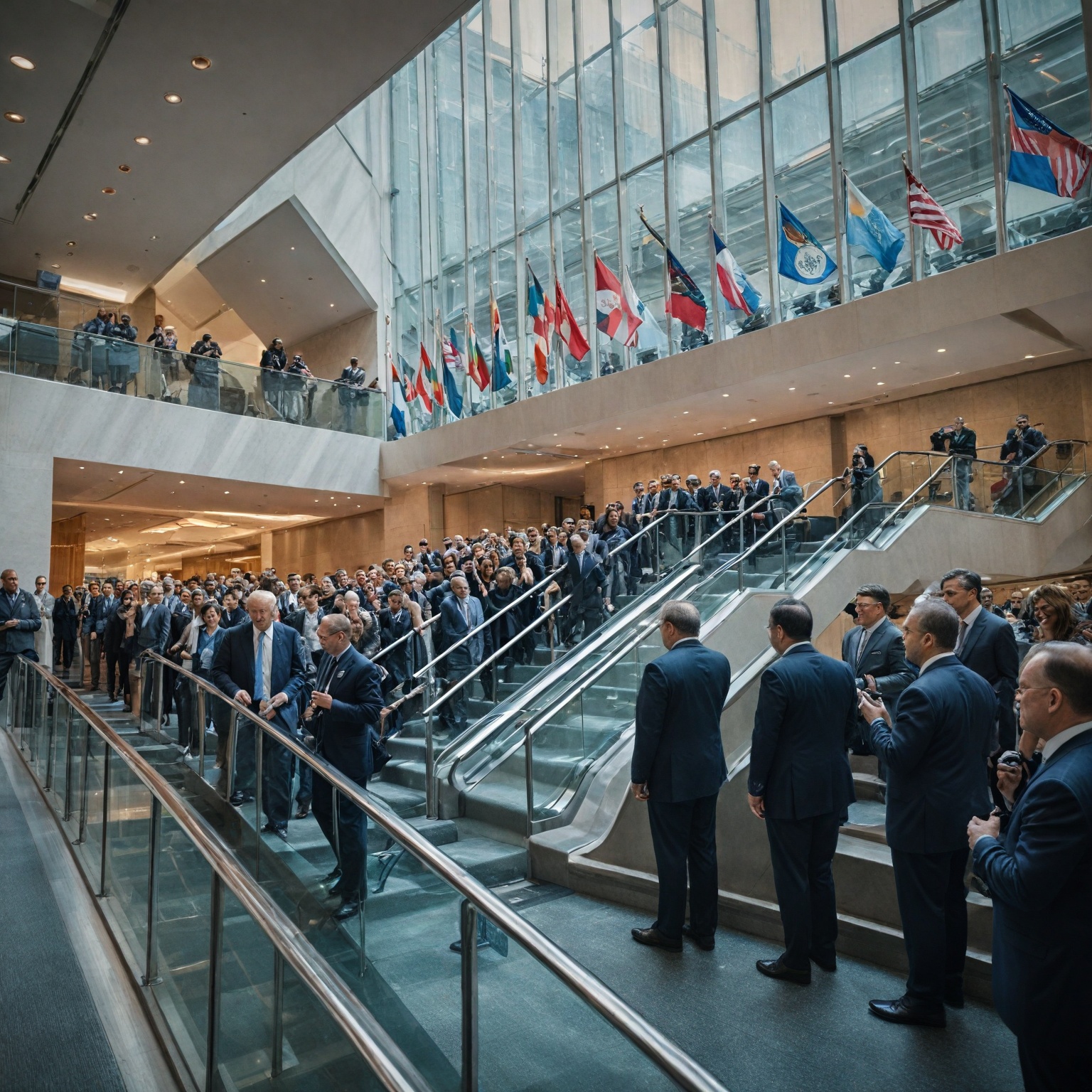Summary
The Trump United Nations escalator snafu refers to an incident on September 23, 2025, during then-U.S. President Donald Trump’s arrival at the United Nations General Assembly in New York City, when an escalator abruptly stopped as he and First Lady Melania Trump stepped onto it. The stoppage, which was captured on video and widely circulated in the media, caused a brief disruption and quickly became a subject of public attention and controversy. The incident drew scrutiny due to the high-profile nature of the event and heightened sensitivities surrounding presidential security.
An official investigation by the United Nations concluded that the escalator’s built-in safety mechanism was inadvertently triggered by a White House videographer who was moving backward on the escalator to film the president’s entrance, causing the system to halt as a protective measure. The escalator was promptly reset by a technician, allowing the presidential delegation to proceed without further issue. The U.N. emphasized that escalator malfunctions are relatively common within its headquarters and rejected allegations of intentional sabotage.
Despite the U.N.’s findings, the Trump administration responded with suspicion and demanded a full investigation, with White House Press Secretary Karoline Leavitt publicly suggesting the stoppage could have been a deliberate attempt to “trip up” the president and first lady. President Trump himself downplayed the incident, humorously referencing it alongside a teleprompter malfunction during his speech, but the episode nonetheless sparked debate over security protocols at international venues and the handling of diplomatic visits.
The incident highlighted the complexities of VIP security and operational logistics at the United Nations, underscoring the challenges of ensuring the safety of visiting dignitaries while maintaining smooth proceedings in a highly scrutinized international setting. It also illustrated how minor technical or human errors can escalate into politically charged controversies in the context of diplomatic events.

Background
The incident involving the escalator stopping abruptly at the United Nations headquarters occurred shortly after U.S. President Donald Trump stepped onto it during his visit. The stoppage was reportedly caused when a White House videographer, who was traveling backward up the escalator in an attempt to film the president’s entrance, inadvertently triggered a built-in safety mechanism designed to prevent people or objects from being caught in the escalator’s gearing. Stéphane Dujarric, spokesman for the U.N. Secretary-General, explained that the safety mechanism activates automatically to ensure the safety of passengers and must be manually reset by a technician, which was done promptly after the American delegation reached the second floor. Such malfunctions are not uncommon at the United Nations headquarters, where escalators have been frequently reported as out of order by visitors and reporters alike. The U.N. maintains strict safety and security regulations that all visitors and staff are required to follow while on its premises, emphasizing proper behavior and adherence to protocols to maintain a professional environment. In the context of high-profile visits, the Chief of Protocol is responsible for coordinating itineraries and ensuring smooth arrangements for heads of state and government officials visiting the U.N., which includes managing logistics surrounding official entrances and movements within the building.
The Escalator Incident
On the day President Donald Trump arrived at the United Nations General Assembly, an escalator suddenly stopped as he stepped onto it, creating a widely viewed moment caught on video. The United Nations initially attributed the stoppage to the triggering of a built-in safety mechanism located on the comb step at the top of the escalator. According to U.N. spokesperson Stéphane Dujarric, the safety mechanism was inadvertently activated by someone ahead of the president on the escalator, which caused the escalator to halt momentarily. Following a one-day investigation, the U.N. concluded that a White House videographer was the likely cause of the incident. The videographer had been moving backward up the escalator to film President Trump’s arrival with First Lady Melania Trump, which unintentionally triggered the escalator’s safety function. A technician promptly reset the escalator, allowing the American delegation to continue up to the second floor without further disruption. While the incident was regarded by many on social media as a trivial and amusing mishap, it prompted a formal investigation and calls for retribution from the Trump administration, reflecting the sensitivity surrounding the event. The U.N. spokesperson also noted that escalators at the U.N. headquarters in New York frequently experience operational issues, suggesting that such malfunctions are not uncommon.
Official Responses
Following the sudden halting of the escalator as President Donald Trump and First Lady Melania Trump stepped onto it at the United Nations General Assembly, reactions from the White House and the United Nations emerged rapidly. President Trump addressed the incident during his speech, humorously referring to the event alongside a malfunctioning teleprompter. He quipped, “These are the two things I got from the United Nations: a bad escalator and a bad teleprompter,” using the mishaps as metaphors to criticize the United Nations for what he described as incompetence and “empty words”. While the president treated the situation lightly, his press secretary, Karoline Leavitt, took a much more serious stance. On the social media platform X, she suggested that the escalator may have been intentionally stopped to “trip up” the president and the first lady, stating, “If someone at the U.N. intentionally stopped the escalator as the President and First Lady were stepping on, they need to be fired and investigated immediately”. This demand for a full investigation highlighted concerns about potential sabotage and the safety risks posed by the sudden stop, with media personalities echoing worries about possible harm to the first couple. The United Nations responded promptly by conducting a one-day investigation into the incident. Stéphane Dujarric, spokesperson for the U.N. Secretary-General, reported that the cause was accidental: a White House videographer inadvertently triggered a safety mechanism that halted the escalator. A U.N. technician confirmed this finding, clearing the United Nations of any intentional wrongdoing. Despite the resolution of the investigation, the episode underscored the importance of safety and security protocols at the United Nations Headquarters, which the United States, as host country, is obligated to uphold under the United Nations Headquarters Agreement. The agreement commits the U.S. to ensuring the safety of all personnel and visitors within the complex, including diplomats and high-profile guests. The incident and subsequent investigation also drew attention to the broader administrative and diplomatic procedures maintained at the United Nations to facilitate the activities of the international community stationed there.
Media Coverage and Public Reaction
The abrupt stoppage of the escalator carrying President Donald Trump and First Lady Melania Trump at the United Nations General Assembly on September 23, 2025, quickly became a subject of intense media scrutiny and public debate. Several media personalities expressed concern for the safety of the president and the first lady, with Fox News host Jesse Watters suggesting that the incident may have been a deliberate act of sabotage. He remarked, “They sabotaged him, and they could’ve hurt the first lady,” amplifying the narrative of a potential intentional disruption. White House Press Secretary Karoline Leavitt strongly condemned the incident, demanding a thorough investigation. She asserted that if anyone at the U.N. had intentionally stopped the escalator, those responsible should be immediately fired and investigated. Leavitt’s firm stance was reiterated multiple times on social media, including a post on X (formerly Twitter) emphasizing the seriousness of the situation and backing the call for accountability. Despite the tension surrounding the escalator incident, President Trump himself took a lighter tone on social media, acknowledging the technical difficulties but downplaying their impact. On Truth Social, he noted that the “teleprompter was broken and the escalator came to a sudden hault [sic] as we were ridding up to the podium,” but added that these glitches “probably made the speech more interesting than it would have been otherwise.” He also expressed honor in speaking at the U.N., despite what he termed “somewhat faulty” equipment. The incident also attracted broader commentary, including from political figures such as California Governor Gavin Newsom, who mocked the escalator mishap, framing it in a political context. Meanwhile, NATO Secretary General Mark Rutte chose to focus on separate security concerns that day, describing it as “too early to say” who was behind a related drone sighting, indirectly contextualizing the tense atmosphere during the U.N. General Assembly. Additionally, some U.N. staffers reportedly joked about turning off the escalators, which further fueled conspiracy theories and speculation on social media, although official statements from the U.N. suggested the escalator stopped due to a triggered safety mechanism and was promptly reset by technicians once the delegation reached the second floor.
Investigation and Findings
The United Nations conducted a one-day investigation into the sudden stoppage of the escalator as President Donald Trump and First Lady Melania Trump stepped onto it during the U.N. General Assembly. According to U.N. Secretary-General spokesperson Stéphane Dujarric, a technician’s review of the escalator’s central processing unit revealed that the abrupt halt was caused by a built-in safety mechanism on the comb step being triggered at the top of the escalator. This safety feature is designed to prevent people or objects from becoming caught in the escalator’s gearing. The investigation concluded that a White House videographer most likely inadvertently activated this safety function, causing the escalator to stop. In addition to the escalator incident, it was reported that the teleprompter operated by the White House for President Trump’s speech also malfunctioned during the event. Despite the technical issues, President Trump humorously referenced the incidents, attributing them to “a bad escalator and a bad teleprompter,” remarks that drew laughter from the assembly. Following the incident, the White House launched its own investigation, emphasizing the need for accountability should any intentional interference be discovered. White House Press Secretary Karoline Leavitt publicly stated on social media that if the escalator stoppage had been deliberate, those responsible at the U.N. should be immediately fired and investigated.
Related Issues and Context
The incident involving the sudden stoppage of the escalator as President Trump and the First Lady were stepping on at the United Nations Headquarters drew significant attention, not only for the immediate disruption but also for the broader implications regarding VIP security and protocol. Beyond the immediate technical issues, the event highlights the complexities involved in VIP protection at international venues such as the United Nations. Ensuring the safety of dignitaries requires meticulous planning, including clear communication protocols and contingency plans to handle unexpected emergencies. These measures are further complicated by the presence of individuals with diplomatic immunity, which necessitates careful coordination and cooperation with foreign governments to navigate security protocols effectively. Moreover, the balance between stringent security measures and the protection of civil liberties presents an ongoing challenge. Democratic societies must safeguard individual rights while maintaining the necessary security frameworks to protect high-profile figures. The role of the Chief of Protocol and the Permanent Mission is also crucial in coordinating arrivals and departures of heads of state and government officials to ensure smooth and secure operations at venues like the United Nations. Taken together, these factors provide important context to the escalator incident and underscore the intricate environment in which VIP security operates.
Aftermath and Impact
Following the incident in which the escalator carrying then-President Donald Trump suddenly stopped during his arrival at the United Nations General Assembly, the U.N. conducted a one-day investigation to determine the cause. The investigation concluded that the stoppage was triggered unintentionally by a videographer from the U.S. delegation who inadvertently activated the escalator’s safety mechanism. A technician promptly reset the escalator after the American delegation had reached the second floor, allowing the event to proceed without further delay. While many on social media viewed the incident as a minor and humorous mishap, the Trump administration treated it more seriously, prompting calls for an official inquiry and potential retribution. Trump’s own reaction was notably lighthearted; he remarked on social media that the broken teleprompter and the escalator halt “probably made the speech more interesting than it would have been otherwise” and expressed continued honor in speaking at the United Nations despite “somewhat faulty” equipment. However, his press secretary took a firmer stance, suggesting that if the escalator stoppage had been intentional, those responsible at the U.N. “need to be fired and investigated immediately”. The episode underscored the importance of stringent security and operational protocols during high-profile international events. It highlighted how unexpected technical or human errors can escalate into significant diplomatic and media incidents, emphasizing the need for cooperation between security teams and technical staff to safeguard dignitaries and maintain smooth proceedings. Additionally, the incident drew attention to the operational rules and behavioral expectations within U.N. premises, reminding visitors to comply with safety and security regulations to prevent similar occurrences.
The content is provided by Sierra Knightley, Front Signals

















